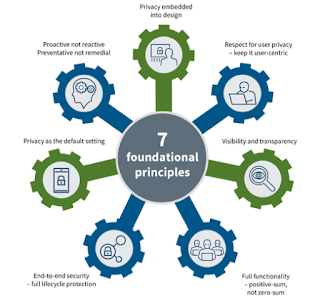Four design principles for developing sustainable AI applications
- Data accessibility. Too often, data is hidden in complex IT systems and/or sits with a vendor. Getting access to the data is often costly and time-consuming.
- Data ownership. Organizations work with many service providers to deliver their e2e value proposition. Oftentimes, the contracts with those providers do not clearly state the ownership of the data, leading to confusion and complex conversations when the data is needed for a new value proposition.
- Data quality. When data is not managed as an asset, there are no quality procedures in place. Checking data quality as late as during the analytics phase is complex and expensive, and should be automated as close as possible to its source.
Security by Design
Privacy by Design
- Proactive not reactive; preventative, not remedial
- Privacy as the default setting
- Privacy embedded into the design
- Full functionality – positive-sum, not zero-sum
- End-to-end security – full lifecycle protection
- Visibility and transparency – keep it open
- Respect for user privacy – keep it user-centric
- The results do not discriminate between different groups of people on the basis of race, nationality, ethnic origin, religion, gender, sexual orientation, marital status, age, disability, or family responsibility. We, therefore, need to minimize the likelihood that the training data sets we use, create or reinforce unfair bias or discrimination
- When optimizing a machine learning algorithm for accuracy in terms of false positives and negatives, one should consider the impact on the specific domain. A false positive is when the system "thinks" someone has, for example, a disease, whereas the person is healthy. A false negative is when a healthy person is incorrectly diagnosed as having a disease. With less false positives and negatives, an algorithm is more accurate, however, minimizing on one usually increases the other. Depending on the domain, false positives and false negatives may have different impacts and therefore need to be taken into account when optimizing algorithms.
- The AI systems are able to explain the “logic” of why it has come to a certain decision, especially for live-impacting decisions. AI systems should not be black boxes.
 Hybrid Cloud
Hybrid Cloud Cyber Security & NaaS
Cyber Security & NaaS AI & Data
AI & Data IoT & Connectivity
IoT & Connectivity Business Applications
Business Applications Intelligent Workplace
Intelligent Workplace Consulting & Professional Services
Consulting & Professional Services Small Medium Enterprise
Small Medium Enterprise Health and Social Care
Health and Social Care Industry
Industry Retail
Retail Tourism and Leisure
Tourism and Leisure Transport & Logistics
Transport & Logistics Energy & Utilities
Energy & Utilities Banking and Finance
Banking and Finance Sports
Sports Smart Cities
Smart Cities





